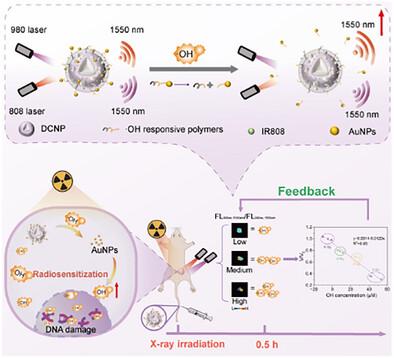x射线激活自校准二次近红外荧光探针用于食管癌精确放射增敏治疗
IF 19
1区 材料科学
Q1 CHEMISTRY, MULTIDISCIPLINARY
引用次数: 0
摘要
放疗效果往往受到肿瘤耐药和缺乏实时治疗监测的限制。为了解决这些挑战,开发了一个多功能纳米平台(DCNP@IR-Au),将x射线响应比率秒近红外(NIR-II)荧光(FL)成像与金纳米颗粒(AuNP)为基础的放射增敏相结合。由于IR808的敏化天线效应,在808 nm激光的激发下,DCNP的荧光强度可以显著增强,但在Au NPs的掺入下,DCNP的荧光强度被猝灭。DCNP@IR-Au的超小AuNPs在x射线照射下产生大量的羟基自由基(·OH),劈开·OH敏感键释放AuNPs,恢复先前被猝灭的FL发射。而980 nm激光激发的荧光强度保持不变。该方法可实现精确的比例NIR-II FL成像,用于定量x射线诱导的·OH水平,检测限为0.40µM。通过建立·OH水平与肿瘤消退效应之间的线性关系,建立基于实时反馈的个性化放射剂量、最小化脱靶毒性、比常规放疗增强1.8倍肿瘤抑制的自适应放疗策略。这项工作将纳米技术与肿瘤治疗的精确放疗联系起来,提供了一个变革性的图像引导平台,以解决放疗耐药性和优化治疗结果。本文章由计算机程序翻译,如有差异,请以英文原文为准。

X-Ray-Activated Self-Calibrating Second Near-Infrared Fluorescent Probes for Precision Radiosensitization Therapy in Esophageal Cancer
Radiotherapy efficacy is often limited by tumor resistance and the lack of real-time therapeutic monitoring. To address these challenges, a multifunctional nanoplatform (DCNP@IR-Au), integrating X-ray-responsived ratiometric second near-infrared (NIR-II) fluorescence (FL) imaging with gold nanoparticle (AuNP)-based radiosensitization is developed. Owing to the sensitization antenna effect of IR808, the fluorescence intensity of DCNP, which can be significantly enhanced when excited by an 808 nm laser, becomes quenched upon the incorporation of Au NPs. The ultra-small AuNPs of DCNP@IR-Au generate a substantial amount of hydroxyl radicals (·OH) under X-ray irradiation, cleaving ·OH─sensitive bonds to release AuNPs, and restoring the previously quenched FL emission. While the FL intensity excited by the 980 nm laser remains constant. This approach enables precise ratiometric NIR-II FL imaging for quantifying X-ray-induced ·OH levels with a detection limit of 0.40 µM. By establishing a linear correlation between ·OH levels and tumor regression effect, an adaptive radiotherapy strategy that personalizes radiation doses based on real-time feedback, minimizing off-target toxicity and enhancing tumor suppression by 1.8-fold compared to conventional radiotherapy, is established. This work bridges nanotechnology with precision radiotherapy for tumor treatment, offering a transformative image-guided platform to address radiotherapy resistance and optimize therapeutic outcomes.
求助全文
通过发布文献求助,成功后即可免费获取论文全文。
去求助
来源期刊

Advanced Functional Materials
工程技术-材料科学:综合
CiteScore
29.50
自引率
4.20%
发文量
2086
审稿时长
2.1 months
期刊介绍:
Firmly established as a top-tier materials science journal, Advanced Functional Materials reports breakthrough research in all aspects of materials science, including nanotechnology, chemistry, physics, and biology every week.
Advanced Functional Materials is known for its rapid and fair peer review, quality content, and high impact, making it the first choice of the international materials science community.
 求助内容:
求助内容: 应助结果提醒方式:
应助结果提醒方式:


